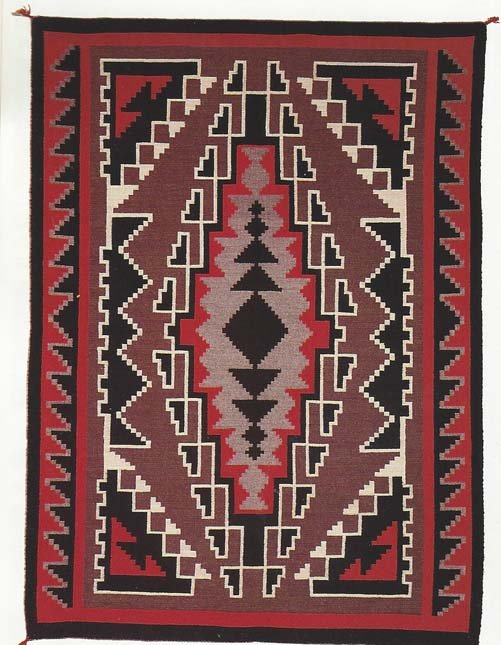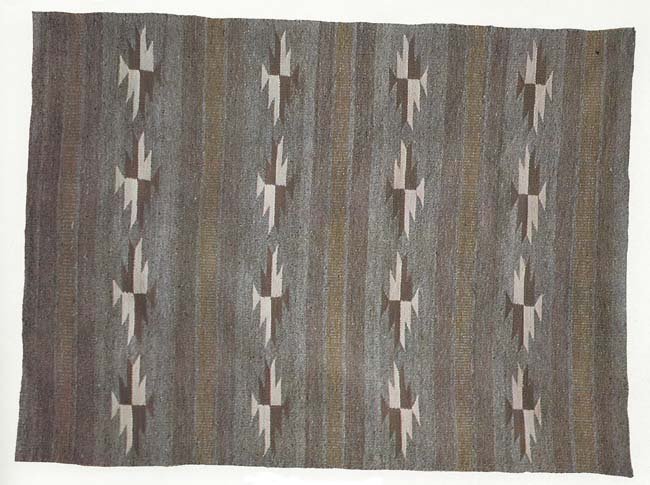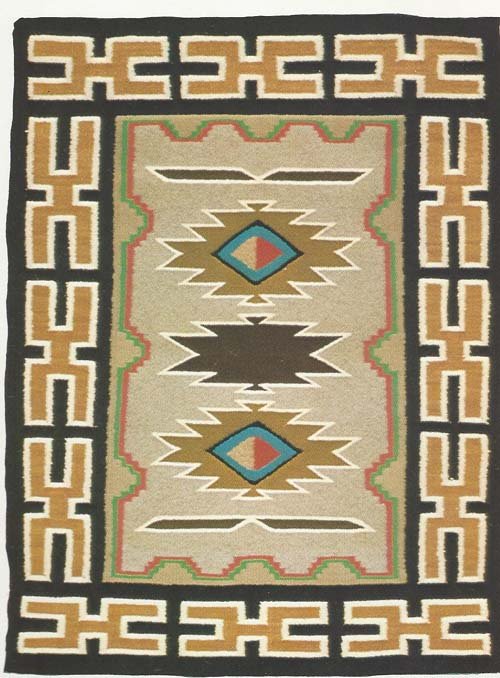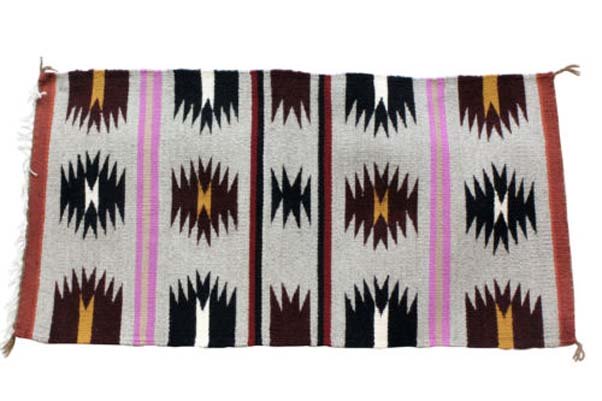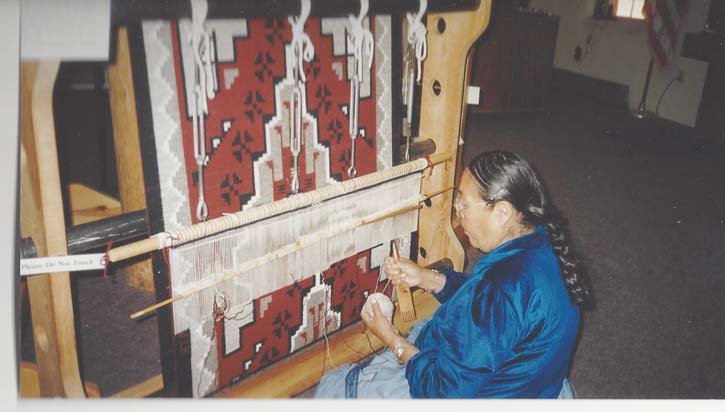NAVAJO RUG ID
Navajo rug ID begins with the ability to recognize some basic regional characteristics. It is important to remember, however, that every rug, like it's weaver, is an individual.
The process of weaving, to the Navajo, is a spiritual one. Each weaver puts her (or occasionally, his) soul and creative energy into the weaving of a rug. Though it may have a characteristic regional design, it will be the interpretation of the weaver that will make that rug its own enduring piece of art.
While basic knowledge of regional characteristics is useful in the study of Navajo rug ID, in the Navajo nation today a rug with a regional name such as Two Grey Hills may have actually been woven by a weaver from a completely different region.
To aid in Navajo rug ID, there are certain ones that can be identified by their distinctive colors, others by the bands of color and the designs within those bands, and certain others by their distinctive designs.

NAVAJO RUG ID #1
RUGS WITH DISTINCTIVE COLORS
These are the Ganado, Klagetoh, Two Grey Hills, and Burntwater rugs described below.
The Ganado and Klagetoh tend to have simpler designs than the similar Two Grey Hills, and Burntwater rugs.
Ganado (Ga-na-doh) Navajo Rugs
Ganado Navajo rugs always have a red background. The distinctive red color is often called a ‘Ganado Red.’ The design, based on a central diamond or two, will be in black, white, and grey in the center of the field.
Simple geometric embellishments can be found on the edges and serrated or stair-stepped diamonds, crosses, zigzags, and simple geometric shapes can be found in the corners outside the central design. There is usually a dark outside border. These rugs can be quite large.
The origin for the Ganado rug is the town of Ganado, Arizona which is in the geographic center of the Navajo Reservation where the famous Hubbell Trading Post stands today.
Klagetoh (Ka-leg-a-toe) Navajo Rugs
Klagetoh rugs are similar to Ganado rugs. The background, however, is grey. The center design is usually an elongated diamond with black, white, and red colors.
Natural wool colors are used, except the red and the black may have some commercial dye. With this rug, the grey can be brownish or even tan, depending upon the fleece of the sheep used.
The name of this rug is from a small area south of Ganado meaning ‘Hidden Springs.’
Two Grey Hills Navajo Rugs
These rugs are woven of natural, undyed, hand spun wool with designs of white, black, and brown. These weavers card together wool from different sheep to produce subtle shades of the white, black, and brown. It is possible to find several different shades of gray, brown, and tan in the same rug.
The wool for the Two Grey Hills rugs is often fine and may require more weaving time, making them more costly. They usually have a plain, dark border. They may also have a spirit line.
The design of the Two Grey Hills does not represent hills. It was named for a village in New Mexico.
Burntwater Navajo Rugs
The Burntwater Navajo rugs display a combination of earth tones and pastels. Colors such as brown, sienna, mustard, and rust are accented with pale colors such as rose, green, blue, white, and lilac.
The designs can use geometric spirals, head-to-head triangles, stepped diagonals, and multiple borders.
The Burntwater style is newer and is basically an expansion
of the traditional Two
Grey Hills
designs by weavers in the Wide Ruins/Burntwater area south of Ganado.
NAVAJO RUG ID #2
BANDED RUGS
The second type of rug for Navajo rug ID are the 3 styles of banded rugs--Chinle, Wide Ruins, and Crystal.
These rugs usually do not have borders.
Chinle (Chin-lee) Navajo Rugs
The Chinle style is the simplest of the 3 Navajo banded rug styles. There are strips of plain color alternating with bands containing repeated geometric designs. These can include squash blossoms, stacked chevrons, and diamonds, and may even have railroad tracks.
Chinle is in the geographic center of the Reservation and was thus a crossroad for travel and commerce.
The Chinle style came before the other 2 banded styles. This was a revival of the borderless and banded designs of the Early Classic Period of Navajo weaving.
Aniline dyes of red and black are used for highlights. They have muted pastels with natural greys, whites, golds, and greens. Occasionally they may also have bright and bold black, white, and red.
The Chinle style originated in the town of Chinle but is now woven everywhere in the Navajo nation. Because of its simplicity, it takes less time to weave and is therefore one of the most commonly woven rugs.
Wide Ruins Navajo Rugs
The Wide Ruins style is the most elaborate and usually the most finely woven of the banded rug styles. It evolved from the Chinle.
These rugs will have broad strips of plain color, some with geometric designs and with very
narrow bands with delicate motifs, combined with thin, straight lines of
contrasting colors. The shapes found within the broader bands are often
outlined with a different color.
The main colors are browns, olives, maroons, and mustards accented with a color such as white, red, or black.
This rug originates from the Wide Ruins, Pine Springs, Burntwater, and Standing Rock region of the Navajo Nation.
Crystal Navajo Rugs
Early Crystals used aniline dyes and were richly designed. They were bordered rugs with a central design woven of natural colors, maybe with a touch of red. After the mid-1940s, the borderless, vegetal-dyed designs came into being.
The difference between the Crystal and the Wide Ruins and Chinle banded design rugs is that the bands in the Crystal are bordered horizontally by wavy lines which are produced by alternating 2 or 3 different colors of weft stands (side to side foundation cords). Also, the vegetal dyes allow for more extensive use of the natural wool colors.
There will usually be 3 bands of wavy lines or a solid color between one or two more complex bands, which are patterned with motifs such as squash blossoms, arrows, stars, crosses, triangles, etc.
Muted earthen colors such as rust, grey, and rich brown, as well as pastel greens, pinks, or yellow are common.
These rugs originated from the Crystal area north of Window Rock, AZ.
NAVAJO RUG ID #3
RUGS WITH DISTINCTIVE DESIGNS
Eye Dazzler Navajo Rugs
This design was said to be influenced by the serape blankets worn in New Mexico. The design is usually a simple geometric shape such as a chevron, diamond, serrate, or triangle, etc. These are either repeated throughout the rug or as a border or even can appear in blocks set against a solid background. The design will appear quite busy and can have a combination of colors.
When Germantown wool from Pennsylvania was originally imported, it afforded the weavers a wonderful range of new colors to work with and this design was perfect for the combining contrasting colors.
Teec Nos Pos (Tees-nos-pas) Navajo Rugs
This rug design looks almost Persian and perhaps least like a Navajo. It is a very busy and bold design with a wide border filled with a variety of motifs, especially a lightning path. It is a complex design and the rugs are often large.
The centers of these rugs are quite elaborate with
feathers, arrows, and claw-like hooks extending from the points of diamonds and
triangles. Zigzags will be everywhere.
There are really no color rules, except they should harmonize. This design also contains a lot of diagonal lines.
The name of the rug comes from a settlement in the NE corner of the Navajo nation and means ‘Cottonwoods in a Circle.’
Storm Navajo Rugs
This is a very interesting rug and has some distinguishable design features. In the center of the rug will be a rectangle that represents the center of the universe.
The 4 rectangles,
one in each corner of the rug, represent the homes of the four winds or the
four sacred mountains of the Navajo world. Zigzag lightning lines connect these
corners with the center.
Colors of the original storm rugs were usually red, black, and white on a natural gray or red background. Today you will find natural browns and vegetal dye colors.
There will usually be a dark border which can be embellished on one side with ‘teeth.’ Clouds, water beetles, arrows, feathers, and geometric designs are throughout.
Storm rugs originated in the Western part of the reservation.
Pictorial Navajo Rugs
Anything is possible with a pictorial rug!
A pictorial usually features items in the daily life of a weaver. There can be landscapes with animals, plants, etc., even tractors. If there are borders, they will usually be dark.
Sandpaintings Navajo Rugs
These are pictorial rugs that show ceremonial sandpaintings. They are square and can contain supernatural figures with magical trappings. They can also include common elements such as snakes, feathers, lizards, and whirling logs.
Because these rugs are sacred, only a few Navajo weavers are willing or able to produce them. To protect these individuals from spiritual harm, special ceremonial sings must be conducted.
These rugs are very rare and thus very valuable and are produced in the Two Grey Hills and Shiprock areas.
Yei (Yay-ee)
Yeis (yays) are the Holy People (supernatural) who can communicate between the Navajo people and their gods. They are usually shown face-front and are tall, slender figures carrying rattles, cornstalks, etc. There are some elements of some sandpaintings but these rugs are not used in ceremonies.
Any combination and amount of colors may be used. They can be commercially or vegetal dyed and contain different numbers of Yei figures. Sometimes these figures are surrounded by the guardian rainbow Yei symbol.
Square faces usually indicate women; round faces are used for men.
These rugs are usually produced in Shiprock, Lukachukai, and Chinle.
Yeibichai (Yay-ba-chay) Navajo Rugs
The Yeibichai rug is a depiction of ceremonies in which human dancers (usually 6) impersonate Yeis (the holy people). These dancers will usually be in profile with one leg bent as if dancing. They can be men or the men alternate with women.
In these rugs, you may find a medicine man administering to a patient. Other figures may also be included such as a clown and a lead dancer.
The Yeibechais are specifically participants of a particular Navajo healing ceremony. Although it is usually a nighttime ceremony, the rug usually does not portray a night scene.
Tree of Life Navajo Rugs
The design of this style of Navajo rug usually portrays a cornstalk or a tree growing out of a basket. There will be brightly colored birds, some recognizable such as Cardinals or Woodpeckers. Some will be flying, others perched or sitting around the basket. Often, butterflies, small animals such as rabbits and squirrels, as well as bright flowers and vines will be present.
The background will usually be a pale color with a plain dark border.
This style originated around the Cedar Ridge area in the northern part of the Navajo Nation.
New Lands (Raised Outline) Navajo Rugs
This type of weaving was developed in the 1950s and involves
a special technique which results in a three dimensional effect, making a
raised outline on the front side. Many of the New Lands weavers come from the Coal Mine Mesa area of the Navajo Nation.
Gallup Throws Navajo Rugs
These are small, loosely woven, pictorial mats meant for the tourist trade and woven in Gallup, New Mexico. They were small, inexpensive and easy to transport, making them popular souvenirs for visits to the Navajo Nation.
"The Cleanest Clean You've Ever Seen."
by
ABC Oriental Rug & Carpet Cleaning Co.
130 Cecil Malone Drive Ithaca, NY 14850
607-272-1566
 Burntwater Rug
Burntwater RugOriental and Area Rug Washing at ABC Oriental Rug
Rugs on the wash floor are gently scrubbed before thorough rinsing.
Gentle scrubbing continues. Note the wringer in the background-the next step in the washing process after rinsing.
After thorough rinsing, the rug is sent slowly and carefully through the wringer to take out as much of the water as possible before being hung on racks in the drying room.
Rugs are hung on a rack in the temperature controlled drying room until completely dry.

